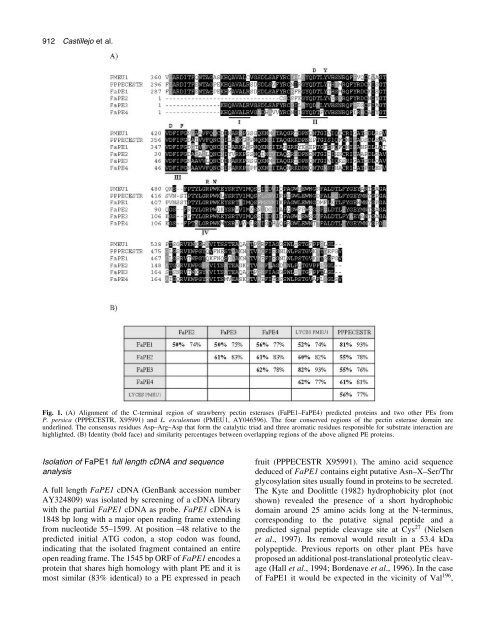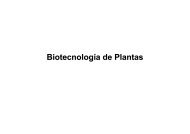Pectin esterase gene family in strawberry fruit - Journal of ...
Pectin esterase gene family in strawberry fruit - Journal of ...
Pectin esterase gene family in strawberry fruit - Journal of ...
Create successful ePaper yourself
Turn your PDF publications into a flip-book with our unique Google optimized e-Paper software.
912 Castillejo et al.<br />
Fig. 1. (A) Alignment <strong>of</strong> the C-term<strong>in</strong>al region <strong>of</strong> <strong>strawberry</strong> pect<strong>in</strong> <strong>esterase</strong>s (FaPE1±FaPE4) predicted prote<strong>in</strong>s and two other PEs from<br />
P. persica (PPPECESTR, X95991) and L. esculentum (PMEU1, AY046596). The four conserved regions <strong>of</strong> the pect<strong>in</strong> <strong>esterase</strong> doma<strong>in</strong> are<br />
underl<strong>in</strong>ed. The consensus residues Asp±Arg±Asp that form the catalytic triad and three aromatic residues responsible for substrate <strong>in</strong>teraction are<br />
highlighted. (B) Identity (bold face) and similarity percentages between overlapp<strong>in</strong>g regions <strong>of</strong> the above aligned PE prote<strong>in</strong>s.<br />
Isolation <strong>of</strong> FaPE1 full length cDNA and sequence<br />
analysis<br />
A full length FaPE1 cDNA (GenBank accession number<br />
AY324809) was isolated by screen<strong>in</strong>g <strong>of</strong> a cDNA library<br />
with the partial FaPE1 cDNA as probe. FaPE1 cDNA is<br />
1848 bp long with a major open read<strong>in</strong>g frame extend<strong>in</strong>g<br />
from nucleotide 55±1599. At position ±48 relative to the<br />
predicted <strong>in</strong>itial ATG codon, a stop codon was found,<br />
<strong>in</strong>dicat<strong>in</strong>g that the isolated fragment conta<strong>in</strong>ed an entire<br />
open read<strong>in</strong>g frame. The 1545 bp ORF <strong>of</strong> FaPE1 encodes a<br />
prote<strong>in</strong> that shares high homology with plant PE and it is<br />
most similar (83% identical) to a PE expressed <strong>in</strong> peach<br />
<strong>fruit</strong> (PPPECESTR X95991). The am<strong>in</strong>o acid sequence<br />
deduced <strong>of</strong> FaPE1 conta<strong>in</strong>s eight putative Asn±X±Ser/Thr<br />
glycosylation sites usually found <strong>in</strong> prote<strong>in</strong>s to be secreted.<br />
The Kyte and Doolittle (1982) hydrophobicity plot (not<br />
shown) revealed the presence <strong>of</strong> a short hydrophobic<br />
doma<strong>in</strong> around 25 am<strong>in</strong>o acids long at the N-term<strong>in</strong>us,<br />
correspond<strong>in</strong>g to the putative signal peptide and a<br />
predicted signal peptide cleavage site at Cys 27 (Nielsen<br />
et al., 1997). Its removal would result <strong>in</strong> a 53.4 kDa<br />
polypeptide. Previous reports on other plant PEs have<br />
proposed an additional post-translational proteolytic cleavage<br />
(Hall et al., 1994; Bordenave et al., 1996). In the case<br />
<strong>of</strong> FaPE1 it would be expected <strong>in</strong> the vic<strong>in</strong>ity <strong>of</strong> Val 196 ,





